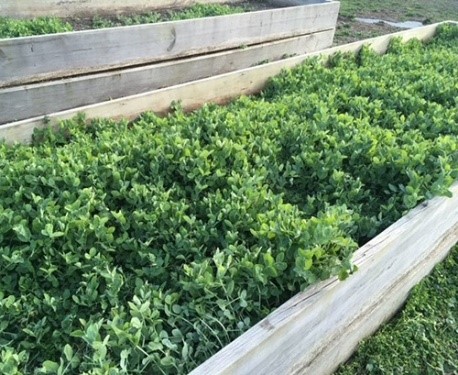Cover Crops to the Rescue
- 2022-09-04
- By mkirk
- Posted in Horticulture, The Garden Buzz
By Pam Rosendal, Colorado Master Gardener
Colorado’s winter winds are brutal for our vegetable gardens; they carry away small particles of topsoil from the soil surface. Add to that the water erosion that washes away its share of topsoil. It’s enough to dishearten even the most experienced home gardener.
Cover crops protect the soil in a vegetable garden from wind and water erosion while, nearly simultaneously, suppressing weeds, fixing nitrogen, building soil structure, and reducing insect pests. Cover crops are vegetable garden superheroes!
A cover crop consists of a large number of plants, usually particular grasses or legumes, that grow and cover the ground, which in turn, improves the soil. Another term used interchangeably with cover crop is green manure. A green manure crop is a cover crop that has been tilled or turned into the soil.
A thick layer of cover crop protects the soil surface from the wind erosion. A cover crop’s roots hold soil in place inhibiting water erosion; grasses are particularly good for this. A cover crop left in place for part or all of a growing season can suppress weeds by releasing biochemicals preventing weed seeds from germinating. Beneficial insects also profit from cover crops, thereby reducing the need for other insect controls including pesticides.

Cover crops are also used to enrich the soil in the garden. Think of it as living compost. The cover crop is mowed after it has reached maturity in early spring but prior to setting seed to avoid it reseeding itself. (Don’t need extra weeds to pull.) It is then tilled into the soil approximately two weeks to one month—depending on the cover crop used—before planting or seeding in the vegetable garden. This allows sufficient time for the (now) green manure to decompose, adding organic matter to the soil as well as nutrients and food for beneficial organisms. All of this adds up to improved soil for your vegetables.
There are a number of cover crops that can be planted such as rye and tillage radish along with many seed mixes available. Tillage radish is especially useful for gardens with compacted soil where its thick roots help to break up the soil.
Cover crops of legumes (e.g., clover, alfalfa) are particularly interesting because of their ability to pull nitrogen from the air and store it in their roots. The nitrogen in the legume’s roots is released into the soil to be used by vegetable plants after it is tilled or turned into the soil as green manure. For the homeowner who has room to devote to a cover crop of legumes for a full growing season, the soil will get a great nitrogen boost along with all the benefits green manure offers.
For those with less space, a mid-September-planted cover crop tilled under in the spring will deliver terrific results.
Ready to plant a cover crop or want to learn more? Check out CSU’s resources on cover crops and benefits of cover crops. Read about Larimer County Horticulture Agent, Alison O’Connor’s experience planting her first cover crop.
Horticulture Resources
- Garden Buzz Archives
- CSU Extension Resources
- Colorado Master Gardener Program
- Foothills to Plains Native Plant Master Program
- Native Bee Watch Community Science Program
- The Co-Hort Blog
- PlantTalk Colorado
- Soil Testing
- Plant Select
- Emerald Ash Borer
- Japanese Beetle
- Colorado State Forest Service
- Ask an Expert



